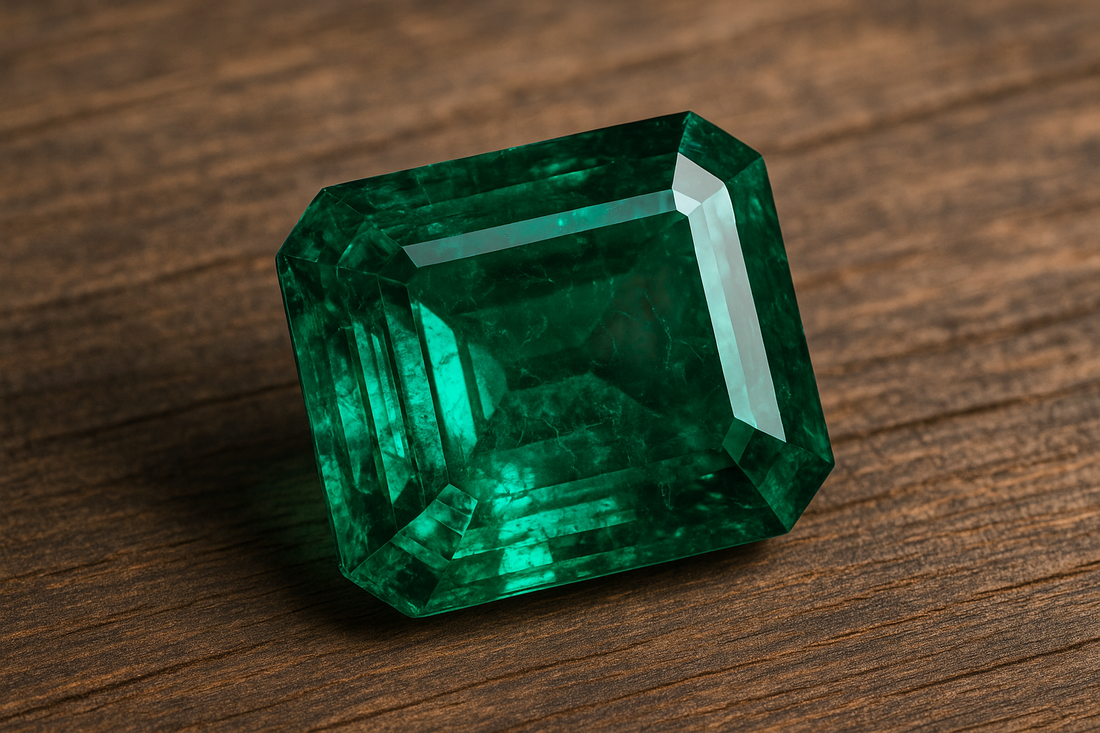
Emeralds | History, Properties & Value
Cody ManesShare
TL;DR
Emeralds, the green variety of beryl colored by chromium and vanadium, have been treasured for millennia. From Cleopatra’s mines to modern Colombian fields, they carry history, rarity, and cultural symbolism. Today they remain among the most valued gemstones worldwide.
Key Facts
| Aspect | Detail |
|---|---|
| Scientific Name | Beryl (Be₃Al₂Si₆O₁₈) with chromium/vanadium |
| Hardness | 7.5–8 on Mohs scale |
| Primary Sources | Colombia, Zambia, Brazil, Afghanistan |
| Famous Wearers | Cleopatra, Indian Mughal emperors, European royalty |
| Symbolism | Rebirth, love, fertility, protection, wisdom |
| Market Value | Highly prized; finest Colombian emeralds can surpass diamond prices |
Q&A
Q: Why are emeralds green?
A: Emeralds owe their captivating green color to trace amounts of chromium and sometimes vanadium within the beryl crystal structure. These trace elements cause selective absorption of light, allowing the gem to display a brilliant green. The intensity and saturation of this color vary depending on the balance of these elements and the conditions during crystal formation. Stones with a pure, rich, evenly distributed green are considered the most valuable. Gemologists often distinguish between stones with a lighter hue, called green beryl, and true emeralds that meet the threshold of saturation and depth of color.
Q: Where are the best emeralds found today?
A: Colombia remains the most famous and important source of emeralds, particularly from the historic Muzo, Chivor, and Coscuez mines. These gems are prized for their deep, pure green and relative transparency, making them benchmarks of quality worldwide. Zambia has emerged as a significant modern producer, with emeralds that often have a slightly bluish-green hue and fewer inclusions than their Colombian counterparts. Brazil produces a wide range of emeralds, from lighter greens to rich, saturated stones, while Afghanistan and Pakistan yield fine emeralds with distinct characteristics. Each locality gives its stones a unique fingerprint that experts can often identify through inclusion patterns and trace element chemistry.
Q: Are emeralds fragile compared to other gems?
A: While emeralds rate a respectable 7.5–8 on the Mohs scale of hardness, they are more fragile than their hardness might suggest because of their common inclusions and fissures. These internal features, often called “jardin” or garden, are a natural part of emerald formation and are widely accepted in the trade. However, they can make emeralds more vulnerable to cracking if struck or exposed to sudden temperature changes. For this reason, emeralds are typically mounted in protective settings and handled with care. Many are also treated with oil to reduce the visibility of fractures and improve clarity, but these enhancements require periodic re‑oiling to maintain appearance. Collectors and jewelers must balance beauty with caution when working with emeralds.
Q: What symbolic meanings have emeralds carried across cultures?
A: Emeralds have long been linked to fertility, rebirth, and eternal youth. In ancient Egypt, Cleopatra declared emeralds as her personal gemstone, associating them with power and immortality. In India, Mughal rulers prized emeralds not only for their beauty but also for their spiritual significance, often inscribing them with verses from the Qur’an. In European traditions, emeralds came to symbolize love, truth, and faith, frequently set in royal crowns and religious relics. Across Latin America, indigenous cultures such as the Muisca of Colombia considered emeralds sacred, using them in rituals and offerings. This rich tapestry of meanings shows how emeralds transcended simple adornment, becoming deeply woven into cultural identity and spiritual practice.
Q: How do gemologists identify natural versus synthetic emeralds?
A: Identifying whether an emerald is natural or synthetic requires close examination under magnification and often advanced testing. Natural emeralds nearly always contain inclusions—small fractures, mineral crystals, or growth structures—that can be diagnostic of their geographic origin. Synthetic emeralds, which have been manufactured since the 19th century, may mimic natural inclusions but often display tell‑tale signs such as curved growth lines or distinctive flux residue. Gemological laboratories also employ spectroscopy and chemical analysis to confirm authenticity. For buyers, requesting certification from reputable labs like GIA or AGL ensures transparency. Synthetic emeralds have value as gems, but they trade at far lower prices than natural stones, making clear identification essential in the marketplace.
Deep Dive
Ancient History and Symbolism
Emeralds have captivated cultures for over 3,000 years. Cleopatra famously claimed ownership of Egyptian emerald mines, and the gem was seen as a symbol of fertility, rebirth, and eternal youth. In India, Mughal emperors had emeralds inscribed with sacred texts, believing the stone carried protective powers. Across Europe, emeralds symbolized faith, wisdom, and eternal love, often set into royal crowns and religious relics.
Ancient physicians also attributed healing powers to emeralds, recommending them for eye strain and as talismans to ward off poison. Medieval lapidaries recorded beliefs that emeralds could calm storms at sea and protect travelers, making them highly valued among sailors and merchants. In astrology, emeralds became linked to Mercury, the planet of communication and intellect, which reinforced the idea that wearing emeralds could improve memory and enhance persuasive speech. These lesser known traditions show how emeralds shaped medicine, travel, and mysticism as much as they influenced art and royalty.
Geological Formation and Properties
Emeralds form under unique conditions where beryllium-rich fluids meet chromium- or vanadium-bearing rocks. This rarity of formation explains their scarcity compared to other beryl varieties like aquamarine. Inclusions, often visible to the naked eye, are considered part of an emerald’s natural fingerprint. Gemologists study these inclusions to identify origins, detect treatments, and distinguish natural stones from synthetics.
A second layer of interest comes from the geological setting of emerald deposits. Many of the finest stones form in regions where tectonic activity and hydrothermal fluids create the perfect environment for crystal growth. These geological fingerprints allow experts to trace emeralds back to specific mining regions such as Colombia, Zambia, and Brazil. Studying these origins not only improves authentication but also provides insight into Earth’s dynamic mineral systems, which is valuable for both gemology and geology.
Treatments and Enhancements
Because emeralds typically have surface-reaching fractures, most are treated with oil or resin to improve transparency. Cedarwood oil is the traditional filler, but modern alternatives like polymer resins may also be used. Treatments affect value, with untreated emeralds commanding significant premiums. Disclosure of treatments is an essential part of gem trading ethics.
A second point of interest is how these treatments interact with long term care. Oils can dry out over time and resins may discolor when exposed to heat or chemicals, which is why jewelers recommend gentle cleaning and occasional professional inspections. Advances in gemology have also introduced analytical tools such as infrared spectroscopy and X-ray fluorescence that help identify not only the presence of fillers but also their type and stability.
Uses in Jewelry and Industry
Emeralds are most commonly cut in the “emerald cut,” a rectangular step cut that reduces stress on the stone and highlights its color. They adorn engagement rings, royal collections, and fine jewelry worldwide. While emeralds have no industrial use, their enduring place in art, history, and culture makes them one of the most symbolic gemstones ever known.
Another fascinating aspect of emerald jewelry is how cultural traditions shaped their use in design. In South America, artisans from the Muisca and Inca civilizations crafted emeralds into offerings and ritual objects, linking the stone to fertility and agriculture. In Europe, gem cutters of the Renaissance perfected techniques to enhance brilliance, creating pieces that became symbols of wealth and political power. Modern designers continue this legacy by blending traditional emerald symbolism with contemporary aesthetics, ensuring that emerald jewelry remains relevant across generations and markets.
Market Value and Collecting
Emeralds rank among the “Big Three” colored gemstones alongside sapphires and rubies. The finest stones, especially untreated Colombian emeralds with deep green color and strong clarity, can surpass diamonds in price per carat. Collectors value provenance, treatment disclosure, and historical significance. Auction houses continue to set records with emerald jewels linked to royalty and celebrities.
Another dimension of emerald collecting involves studying geographic origin and how it impacts price and desirability. Colombian emeralds often command the highest values due to their legendary hue, but Zambian emeralds with bluish tones and Brazilian emeralds with lighter clarity have carved respected positions in the market. Origin reports issued by gemological laboratories add credibility and increase confidence among buyers, supporting the importance of transparent documentation in today’s emerald trade.
Sources
GIA – Gemological Institute of America: Emerald Guide
International Gem Society – Emerald Gemstone Profile
Sinkankas, John. Emerald and Other Beryls. Chilton Book Company
Ringsrud, Ronald. Emeralds: A Passionate Guide. Green View Press, 2009
